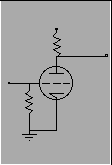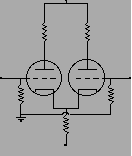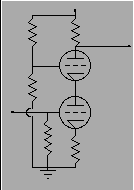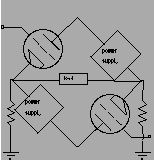Because we build OTL amplifiers, people often think that we are making a conventional Futterman design. This is untrue. Our products are designed around a central concept: that symmetrical designs are inherently low distortion, with excellent stability. We build output transformerless circuits that embrace this idea. This paper is designed to shed some light on the technology involved.
Most of the circuitry used in our equipment was designed in the 1940s and 50s, ostensibly for military purposes. We use differential amplifiers, cascode amplifiers and bridge amplifiers for all of our amplifier building blocks. We will discuss the advantages of each, as well as how they were used to create our Balanced Differential Design™.
|
To understand the operation of the more advanced circuitry, it is important to understand the basic circuits. The single-ended triode circuit, shown in Figure 1, has been in use since the 1920s, and is the basic building block of 99% of all tube preamplifiers and most tube amplifiers in use today. It is amazing that so much of what is in use today was designed so long ago.
The triode amplifier in its basic form as shown has a low parts count, fairly good linearity (compared to pentode and transistor circuits) |
 Figure 1, triode Amplifier |
 Figure 2, Differential Amplifier |
Differential amplifiers are the basic building block of our voltage amplifiers. Differential amplifiers have a number of advantages over conventional single-ended amplifiers. Differential amplifiers are a type of balanced amplifier, although certainly not the only type. A differential amplifier consists of two single stages of gain, connected together by their cathodes (or other emitting devices). This means that there two inputs to a differential amplifier and two outputs. Any signal at the input of one side of the amplifier will result in two outputs, equal but opposite of each other. The main advantages are: |
There are also some disadvantages:
On the bench, in the textbook and in real life, differential amplification provides greater performance, particularly from DC to 100 KHz, the audio region. Reliability in practical terms equals or exceeds that of conventional single-ended circuits, if designed properly.
|
Cascode amplifiers are another method of using two triodes in a single stage of gain. In this case, the plate of the first tube is used to drive the cathode of the second (top) tube, as shown in Figure 3. The top tube is arranged as a constant current source, which has the effect of acting like the circuit of Figure 1 with a very large plate resistor and a very high plate voltage. In this arrangement, the gain and linearity are substantially improved over basic triode amplifiers. The gain can approach the amplification factor of the tube squared, which means that gain is nearly that of a pentode circuit, but with low distortion typical of triode amplifiers. The advantages are: |
 Figure 3, Cascode Amplifier |
The main disadvantage is:
 Figure 4, Bridge Amplifier |
A bridge amplifier is a type of balanced amplifier with some unique properties. One of the most important is the ability to couple the output of the amplifier directly to any voltage level. This means that a bridge amplifier can be direct-coupled as a preamplifier or amplifier output, which are at ground potential. A bridge amplifier consists of two single-ended amplifiers connected together as a bridge circuit, as shown in Figure 4. It therefore has two inputs, for push-pull operation, like a differential amplifier. The advantages of this circuit are: |
There are also certain disadvantages:
By creative combination of the above circuitry, we have created a tube circuit not used in tube amplifiers before: the differential cascode. This type of circuit has all the advantages of cascode and differential amplifiers, resulting in an amplifier that has fewer parts for the amount of gain available then is possible using conventional triode circuits, while at the same time having lower distortion and noise. This, plus the use of bridge amplifiers, makes possible our power amplifier and preamplifier circuitry which is fully differential and balanced from input to output. We call this Balanced Differential Design™.
The advantage of this technique is that distortion is canceled at each stage in the circuit, meaning that the succeeding stage will not have to amplify that distortion. This results in much lower distortion and natural sound, while at the same time allowing for high gain and low noise. Our preamplifier has the greatest phonograph input sensitivity of any tube preamp made (good to .07 mv), and yet there are only three gain stages in the entire preamplifier. The result is ultimate simplicity, reliability and musicality, which is the hallmark of this type of amplification. In addition, ATMA-SPHEREŽ MUSIC SYSTEMS has developed a method of further reducing distortion in the bridge amplifier, while retaining its normal advantages. Thus it is possible to create an amplifier with extremely low distortion and wide bandwidth, even without negative feedback. This allows improved dynamic range, which enhances realism.
The overall effect of this technology is the first "high tech" vacuum-tube line ever conceived and manufactured. A new level of musicality is also achieved, without sacrificing reliability.
For the inspired enthusiast of vacuum tube technology, the following texts are extremely informative and well worth the effort to find. Good Luck!
last updated: March 6, 1998
©1996, 1997, 1998
Atma-Sphere® Music Systems, Inc. All rights reserved.
Electronics for those who prefer music. You'll be hearing more from us.